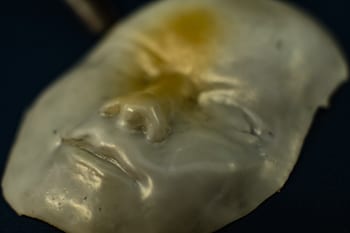2018/12/21 アメリカ合衆国 ハーバード大学

・ ハーバード大学が、新タイプの導電性溶液で作製する無毒性の柔らかいウェアラブルセンサーを開発。
・ 同センサーは指に取付けるだけで把持強度や手・指の動きを測定。大型でかさ張るセンサーが装着できない乳幼児の神経運動機能障害等の早期発見を目指した正確な測定での利用を想定した。
・ 一般的な栄養補助食品のヨウ化カリウムと食品添加物のグリセロールから成る新しい導電性溶液は、塩水の小滴よりも安全で導電性が従来の生体適合性溶液の 4 倍。そのためノイズの少ないクリーンなデータが得られる。
・ ヨウ化カリウムとグりセロールの混合後、グリセロールがヨウ化カリウムの結晶構造を直ちに破壊してカリウムカチオン(K+)とヨウ化物イオン(I-)が形成されて溶液が導電性に変わる。グリセロールは水よりも蒸発率が低く、ヨウ化カリウムは極めて溶けやすいため、溶液は広範囲の温度や湿度レベルで安定すると共に高導電性となる。
・ 従来の生体適合性ソフトセンサーでは塩化ナトリウムとグリセロールの溶液を使用したが、導電性が低いためセンサーデータのノイズが多くなり、作製には約 10 時間かかった。新溶液ではこれを約 20 分に短縮。クリーンなデータも獲得できる。
・ 乳幼児向けのウェアラブルセンサー開発に着目することで、小型、軽量、非侵襲的なウェアラブルデバイスへの多様なセンサー統合の課題が明らかになった。このようなウェアラブルセンサーが実現できれば、診断や治療に向けたヒューマン・マシン・インターフェースや VR へのアプリケーションの可能性につながると考える。
・ 今回は成人による試験を実施したが、今後はデバイスの小型化により幼児の手に装着して試験を実施予定。同大学の Office of Technology Development が同センサー構造に関する知的財産ポートフォリオを申請済み。同技術の商業化の機会を探求中。米国立衛生研究所(NIH)が本研究を支援した。
URL: https://www.seas.harvard.edu/news/2018/12/safe-wearable-soft-sensor
(関連情報)
Advanced Functional Materials 掲載論文(アブスとラクトのみ:全文は有料)
Biocompatible Soft Fluidic Strain and Force Sensors for Wearable Devices
URL: https://onlinelibrary.wiley.com/doi/10.1002/adfm.201807058
<NEDO海外技術情報より>
Abstract
Fluidic soft sensors have been widely used in wearable devices for human motion capturing. However, thus far, the biocompatibility of the conductive liquid, the linearity of the sensing signal, and the hysteresis between the loading and release processes have limited the sensing quality as well as the applications of these sensors. In this paper, silicone based strain and force sensors composed of a novel biocompatible conductive liquid (potassium iodide and glycerol solution) are introduced. The strain sensors exhibit negligible hysteresis up to 5 Hz, with a gauge factor of 2.2 at 1 Hz. The force sensors feature a novel multifunctional layered structure, with microcylinder‐filled channels to achieve high linearity, low hysteresis (5.3% hysteresis at 1 Hz), and good sensitivity (100% resistance increase at a 5 N load). The sensors’ gauge factors are stable at various temperatures and humidity levels. These biocompatible, low hysteresis, and high linearity sensors are promising for safe and reliable diagnostic devices, wearable motion capture, and compliant human–computer interfaces.



